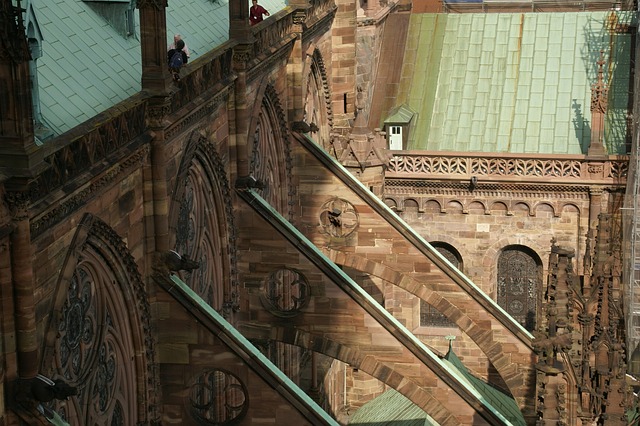Flying buttress
A buttress is a structure built against another structure in order to strengthen or support it. Historically, buttresses have been used to strengthen large walls or buildings such as churches.
Flying buttresses consist of an inclined beam carried on a half arch that projects from the walls of a structure to a pier which supports the weight and horizontal thrust of a roof, dome or vault. This thrust is carried by the flying buttress away from the building and down the pier to the ground. The pier is frequently crowned by a pyramidal or conical ornament known as the pinnacle, which helps to add weight and improve stability.
The balancing of forces by the addition of flying buttresses has enabled buildings to become much taller and more elaborate. They are a common feature of Gothic architecture and are often found in medieval cathedrals.
Romanesque architecture dating back to the 10th century featured internal buttresses as supporting elements for the inside of church walls. Towards the end of the Romanesque period, architects were aspiring to build churches and cathedrals on an ever-more ambitious scale, and with the arrival of the Gothic period in the 12th century, flying buttresses were introduced as a means of making such buildings taller. By directing the weight of the roof away from the walls, more windows could also be incorporated which provided cathedrals with much more natural light.
One of the most prominent cathedrals to include flying buttresses was Paris’ Notre Dame which began construction in 1163 and was completed in 1345. Flying buttresses were also a distinctive feature of the Saint Chapelle in Paris, the Duomo in Milan, and the cathedrals at Chartres, Rouen, Reims, Amiens, as well as London’s Westminster Abbey.
Flying buttresses continue to be used in large modern structures such as retaining walls and dams.
[edit] Related articles on Designing Buildings Wiki
- Arch.
- Architectural styles.
- Barrel vault.
- Buttress.
- Cantilever.
- Classical orders in architecture.
- Conoid shell.
- Corbel.
- Elements of classical columns.
- English architectural stylistic periods.
- Load-bearing wall.
- Masonry.
- Pediment.
- Pendentive dome.
- Piers.
- Pinnacle.
- Purlins.
- Shell roof.
- Suspended ceiling.
- Types of dome.
- Vault.
Featured articles and news
RTPI leader to become new CIOB Chief Executive Officer
Dr Victoria Hills MRTPI, FICE to take over after Caroline Gumble’s departure.
Social and affordable housing, a long term plan for delivery
The “Delivering a Decade of Renewal for Social and Affordable Housing” strategy sets out future path.
A change to adoptive architecture
Effects of global weather warming on architectural detailing, material choice and human interaction.
The proposed publicly owned and backed subsidiary of Homes England, to facilitate new homes.
How big is the problem and what can we do to mitigate the effects?
Overheating guidance and tools for building designers
A number of cool guides to help with the heat.
The UK's Modern Industrial Strategy: A 10 year plan
Previous consultation criticism, current key elements and general support with some persisting reservations.
Building Safety Regulator reforms
New roles, new staff and a new fast track service pave the way for a single construction regulator.
Architectural Technologist CPDs and Communications
CIAT CPD… and how you can do it!
Cooling centres and cool spaces
Managing extreme heat in cities by directing the public to places for heat stress relief and water sources.
Winter gardens: A brief history and warm variations
Extending the season with glass in different forms and terms.
Restoring Great Yarmouth's Winter Gardens
Transforming one of the least sustainable constructions imaginable.
Construction Skills Mission Board launch sector drive
Newly formed government and industry collaboration set strategy for recruiting an additional 100,000 construction workers a year.
New Architects Code comes into effect in September 2025
ARB Architects Code of Conduct and Practice available with ongoing consultation regarding guidance.
Welsh Skills Body (Medr) launches ambitious plan
The new skills body brings together funding and regulation of tertiary education and research for the devolved nation.
Paul Gandy FCIOB announced as next CIOB President
Former Tilbury Douglas CEO takes helm.
UK Infrastructure: A 10 Year Strategy. In brief with reactions
With the National Infrastructure and Service Transformation Authority (NISTA).

























Comments
This is a very great raliable source!!!